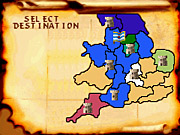Defender of the Crown is a strategy game somewhat like Risk. You play the role of an inexperienced lord of a small territory in feudal England. Gameplay centers primarily on the building of armies and the capturing of neighboring territories, but there are also action segments where you participate in jousting tournaments or chuck cannonballs toward rival castles.

There's a basic storyline to the game, but it's not very deep. The game is set in the 1100s, and the Normans in the south of England have murdered the king and fractured the country into five rival factions. As a Saxon in the north, your goal is to enlist troops and expand your kingdom in order to conquer the Normans and reunite England. The one cute aspect of the story is that one of your allies throughout the game is Sir Robin of Locksley, better known as Robin Hood. All further interaction with the characters takes place in competition, either on the battlefield or in the jousting arena.
The initial structure of the game is much like a typical board game, where players take turns performing a variety of tasks such as troop movements, castle building, and recruitment. There is a great deal of strategy involved in capturing territory. You have to decide whether to invade lands surrounding your enemies in order to stall their movement or to take areas near your own territory that will earn quick money. From the map screen, you can also station garrisons on neighboring territories, seek the assistance of Robin Hood, or gather the country together for jousting tournaments.
Once you move troops onto enemy territory or sponsor a joust, however, Defender of the Crown becomes a series of real-time minigames. When you engage in battle, your first task is to aim and launch catapult strikes against the enemy castle, which you can then invade with your troops. During the fight, you can command your troops to attack with three different strategies or to make a hasty retreat. How hard your forces fight depends on your leadership rating, and success in battle earns you additional territory. By contrast, a joust lets you acquire land and leadership experience through friendly competition. Here, you have to aim your lance in order to knock your opponent from his horse, and then face off against him from the ground with a mace and shield. There's also an infrequent minigame that involves raiding a castle with a lone knight and swordfighting with guards in order to steal extra money or rescue a damsel in distress.
Although these fast-paced diversions breathe life into the game's otherwise stoic strategy portions, they're not altogether deep or satisfying. It doesn't take much skill to aim a lance with the D-pad or to launch a catapult with the A button, especially since the timing and targets never change. They're decent for their intended purpose, however, which is to give you more ways to acquire land and maintain your leadership rating.
Defender of the Crown also has a classic feel about it, which is no doubt due to its roots on the Commodore 64 and Amiga computers of the 1980s. The interface is full of menus that absolutely beg for a mouse pointer, while CPU behavior is utterly ruthless--at least until you learn the infallible tricks that will enable you to win every joust and every battle. On the upside, however, the game now includes a battery save to record a game in progress, which means you don't have to devote full three-hour stretches to a single campaign.
Despite its cumbersome interface, the game scores high praise for its medieval style and crisp character animation. The original Amiga version used digitized artwork and large character sprites to convey an almost photographic perspective. The Game Boy Advance version uses the exact same backgrounds and character artwork, albeit with minor changes because of the system's tinier screen resolution. If you're used to modern strategy games, you'll find the settings in Defender of the Crown pretty lifeless, as there are only a few minor flame and lighting effects spread throughout the 10 or so backgrounds. Lifeless or not, this is the best this game has ever looked, and it's sure to please those who remember the garish colors of the old NES version.
The audio isn't totally on par with other strategy games on the GBA, but the casual blend of musical segues and digitized effects forms a pleasing soundtrack. In battle, you can hear the shouts and thunderous roar of hundreds of stampeding soldiers. During the joust, the footsteps of your mount crash loudly to the ground and audibly kick up dust and dirt. Unfortunately, most of your time is spent on the map screen, which doesn't feature any of these wonderful auditory interludes.
Judging from the various message boards scattered throughout the Internet, Defender of the Crown has a large and loyal following. If you're one of its many supporters, then the GBA version will be a welcome addition to your game library. It plays just as well as the game you've been enjoying for years, looks better, and it's portable.

Defender of the Crown isn't that lengthy of a game, however, and that could be a problem for many of today's more discerning players. Once you learn the tricks to victory, all that remains is to beat the game with each of the four included characters. Also unfortunate is that the game doesn't have any multiplayer features, which may have made sense for a computer game in the 1980s but is perplexing for a GBA game in 2002, especially one that is turn-based.
Metro3D, Crawfish, and Cinemaware deserve a great deal of credit for bringing such a beloved game out of retirement. Anyone who has played Defender of the Crown on the Commodore 64, Amiga, or NES will quickly fall in love with the GBA version. It's just too bad the developers didn't see fit to add any new gameplay features or a multiplayer mode.